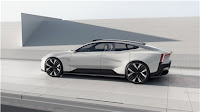Polestar is the Swedish company Volvo's electric vehicle division, and both are owned by Chinese parent company Geely. It is headquartered in Gothenburg, Sweden with vehicle production taking place in Chengdu, China.
It is already up and running and selling cars worldwide. And it's turning heads with its clean, Nordic designs.
Polestar recently unveiled the Polestar Precept – a vision of how the brand sees its future styling direction.
The company's division says, in typically Nordic and logical language, "we believe that a car should stand out because every part of it has been thoroughly thought out."
The name “Precept” was chosen to emphasise the vehicle’s role in setting out Polestar’s intent as the contemporary electric performance brand.
A precept is a manifesto of things to come; a declaration. The car signifies an important milestone for Polestar as a standalone brand, describing a unique design philosophy that remains firmly embedded in Polestar’s brand values: pure, progressive and performance.
“Precept is a declaration, a vision of what Polestar stands for and what makes the brand relevant,” says Thomas Ingenlath, CEO of Polestar. “The car is a response to the clear challenges our society and industry face. This is not a dream of a distant future, Polestar Precept previews future vehicles and shows how we will apply innovation to minimise our environmental impact.
Indeed, the car is not too far in looks from the 2021 Polestar 1, an incredibly handsome vehicle (on sale now for about $60k.)
Precept features an integrated front wing above the SmartZone which accelerates air flow over the long hood. This allows air to attach itself to the surface earlier, which improves aerodynamic efficiency and thus improves the vehicle’s range.
Minimalistic athleticism, the sculpted form of the Polestar Precept sets the tone for future Polestar vehicles. The vehicle’s proportions define its presence with restrained surfacing and a focus on aerodynamic efficiency. A 3.1-metre wheelbase which accommodates a large battery pack gives the four-door vehicle a very low silhouette, and better leg-and-head room in the back seat.
The front grille is replaced by the Polestar SmartZone, representing, "a shift from breathing to seeing," the company says. An area which once channelled air to radiators and the internal combustion engine now houses technology for safety sensors and driver assistance functions.
Purposefully gathered behind a transparent panel dedicated to intelligent hardware are two radar sensors and a high definition camera. The LIDAR pod, mounted atop the glass roof, is given optimal visibility as a next step towards increased driving assistance. The Thor’s Hammer-style LED headlight style evolves with separated elements, taking on a dynamic, more robotic and brand-defining interpretation.
At the rear, the wide blade-like light fixture spans the entire width of the car, extending into vertical aero-wings – another aerodynamic feature and a nod to light-weight design.
There are, of course, some flights of fancy, and fantasy, that won't likely be seen on the production car.
Conventional side mirrors are replaced here by camera-based units, each of which extends outwards on an aerodynamic arm.
The absence of a conventional rear window means that the Precept’s single-volume glass roof extends behind the rear seats and the tailgate itself is designed with a larger opening and higher-mounted hinges improving access. This obviously will be replaced in the production car with a proper rear window for visibility.
That's not to say some future tech won't make it into this car. Inside, the traditional rear-view mirror is replaced with a digital screen, the image collected by a wide-angle camera mounted at the rear of the car.
This technology is already creeping into several vehicles in 2020, including some GM cars like the Cadillac CT6 and some Lexus models. It's a neat feature that allows you to avoid the 3 adult's heads in the back seat because the camera is on the back of the roof.










